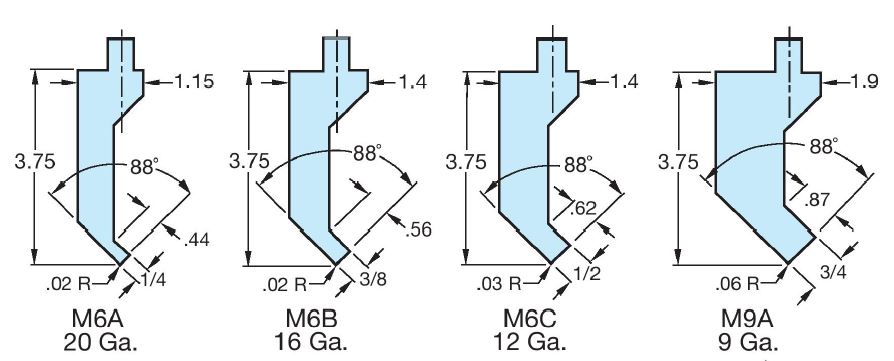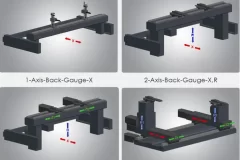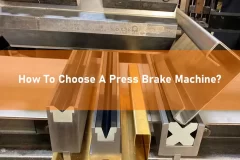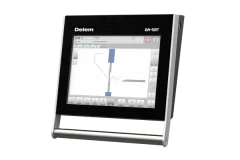Types of Press Brakes
The two main types of press brakes are mechanical press brakes and hydraulic press brakes. These classifications are based on the method used to apply force for bending the sheet metal. Each type has its own advantages and considerations:
1.Mechanical Press Brakes:
Mechanism: Mechanical press brakes use a mechanical linkage, typically consisting of a flywheel and a clutch, to generate the force needed for bending. The flywheel is engaged by a clutch, storing energy, and then released to drive the ram down with force.
Characteristics:
Faster Approach Speed: Mechanical press brakes often have a faster ram approach speed, which can contribute to quicker bending cycles.
Limited Control: The mechanical nature may provide limited control over the ram’s speed and force during the bending process.
Suitable for Simple Bends: Mechanical press brakes are well-suited for applications that involve simple bends and do not require highly precise control.
2.Hydraulic Press Brakes:
Mechanism: Hydraulic press brakes use hydraulic cylinders to apply force to the ram. The hydraulic system allows for precise control of the bending force and speed.
Characteristics:
Precision Control: Hydraulic press brakes provide more precise control over the bending process, allowing for better accuracy and repeatability.
Versatility: Hydraulic press brakes are versatile and suitable for a wide range of applications, from simple bends to complex forming operations.
Variable Speed: The hydraulic system allows for variable ram speeds, making it easier to achieve different bending profiles.
Energy Efficiency: Hydraulic press brakes can be more energy-efficient than mechanical ones, especially during idle periods.
Both mechanical and hydraulic press brakes have their advantages, and the choice between them depends on the specific needs of the application. Hydraulic press brakes are more common in modern metal fabrication due to their versatility, precision, and ease of control. However, mechanical press brakes may still be suitable for certain applications, especially if speed is a critical factor and the bending requirements are relatively straightforward.
Press Brake Tooling

Press brake tooling refers to the various components, such as punches and dies, that are used in a press brake machine to shape and bend sheet metal. These tools are essential for achieving specific bending profiles and forming different geometries. Press brake tooling comes in a variety of shapes and sizes to accommodate diverse applications. Here are key components of press brake tooling:
1.Punch:
The punch is the upper tool that applies force to the sheet metal, causing it to bend against the lower die. Punches come in different shapes, including V-dies for standard bends and specialized punches for complex forming.
2.Die:
The die is the lower tool that provides the bending surface against which the sheet metal is formed. Dies also come in various shapes, such as V-shaped dies for common bends. The combination of punches and dies determines the final shape of the bend.
3.V-Die:
V-dies are a common type of die used in press brake tooling. They have a V-shaped groove, and the width of the V can vary. V-dies are versatile and can be used for a wide range of bending applications.
4.Bottoming Die:
A bottoming die, also known as a flattening die, is used for precision bending. It reduces the springback effect, resulting in a more accurate and repeatable bend.
5.Gooseneck Punch:
Gooseneck punches have a curved or extended shape, allowing for bends close to the edge of the material. They are useful in situations where the workpiece requires bending in tight spaces.
6.Offset Punch:
Offset punches have an offset design, providing flexibility for bending complex shapes. They are particularly useful when forming parts with varying angles.
7.Hemming Tool:
Hemming tools are used for creating hems or flanges on sheet metal edges. They can be designed for different hemming angles and widths.
8.Radius Tooling:
Radius tooling, including radius punches and dies, is used to achieve rounded bends in the sheet metal. This is common in applications where sharp corners are not desired.
9.Specialty Tooling:
Depending on the specific requirements of a project, press brake tooling manufacturers may offer specialty tools designed for unique bending applications. This could include tools for forming louvers, embossing, or other specialized shapes.
10.Clamps and Hold-Downs:
These are auxiliary tools that help secure the sheet metal in place during the bending process, preventing movement and ensuring accurate bends.
When selecting press brake tooling, it’s essential to consider the material type, thickness, and the desired bending profile. Proper tool selection contributes to the accuracy, repeatability, and overall quality of the formed parts. Manufacturers often provide tooling catalogs with a wide range of options to suit various applications.



